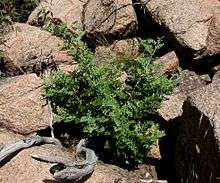Grevillea willisii
| Grevillea willisii | |
|---|---|
 | |
| Grevillea willisii, Bundara River, Alpine National Park, Victoria | |
| Scientific classification | |
| Kingdom: | Plantae |
| (unranked): | Angiosperms |
| (unranked): | Eudicots |
| Order: | Proteales |
| Family: | Proteaceae |
| Genus: | Grevillea |
| Species: | G. willisii |
| Binomial name | |
| Grevillea willisii R.V.Sm. & McGill.[1] | |
Grevillea willisii is a shrub species which is endemic to the eastern highlands of Victoria, in Australia.[2] Common names include Omeo Grevillea and Rock Grevillea.[2]
It has a spreading or habit, growing to between 2 and 4.5 metres high, and generally has a grey-green appearance.[2][3] The leaves are slightly prickly and deeply lobed. Both the underside of the leaves and the stem are covered by dense, light-coloured hairs.[3] Flowers appear in terminal spikes between September and January (early spring to mid summer) in its native range.[2] These have cream perianths and pale yellow styles. The fruits have contrasting dark streaks.[3]
The species was first formally described in 1975 in the journal Muelleria.[1] The specific epithet honours James Hamlyn Willis, the Government Botanist of Victoria.[3]
Two forms are recognised:
- A shorter-leaved (type) form. This occurs to the north and east of Omeo.
- A longer-leaved form from the south of Corryong, which has scented flowers.[2]
A former subspecies G. willisii subsp. pachylostyla from the upper reaches of the Buchan River was promoted to species status (Grevillea pachylostyla) in 1994.[4]
G. willisii occurs on rocky granite outcrops and near streams in the vicinity of the Mitta Mitta River and Nariel and Wheelers Creek.[2]
The species has a ROTAP listing as "2RC-".[5] It is listed as "Rare in Victoria" on the Department of Sustainability and Environment's Advisory List of Rare Or Threatened Plants In Victoria.[6]
Cultivation
Plants may be grown to attract birds to a garden, providing both protection for nests and a source of nectar. Plants are occasionally affected by leaf miners or chlorosis of the leaves. The species may be propagated by semi-mature cuttings, which may take up to 5 months to produce roots.[3]
The hybrid cultivar Grevillea 'Poorinda Anticipation' is a cross between G. longifolia and G. willisii.[7] Grevillea 'Poorinda Royal Mantle' is a vigorous cultivar that was bred by Victorian plantsman Leo Hodge and registered in 1978; it is thought to be a hybrid between G. willisii and G laurifolia.[8]
References
- 1 2 "Grevillea willisii". Australian Plant Name Index (APNI), IBIS database. Centre for Plant Biodiversity Research, Australian Government, Canberra. Retrieved 2010-06-06.
- 1 2 3 4 5 6 "Grevillea willisii". Flora of Australia Online. Department of the Environment and Heritage, Australian Government.
- 1 2 3 4 5 Butler, Geoff (1993). "Grevillea willisii". Growing Australian Plants. Retrieved 2010-06-06.
- ↑ "Grevillea pachylostyla". Flora of Australia Online. Department of the Environment and Heritage, Australian Government.
- ↑ "Grevillea willisii". PlantNET - New South Wales Flora Online. Royal Botanic Gardens & Domain Trust, Sydney Australia. Retrieved 2010-06-06.
- ↑ "Advisory List of Rare Or Threatened Plants In Victoria - 2005" (PDF). Department of Sustainability and Environment (Victoria). Archived from the original (PDF) on 2012-03-24. Retrieved 2012-01-15.
- ↑ "Grevillea 'Poorinda Anticipation'". List of Registered Cultivars derived from Australian native flora. Australian Cultivar Registration Authority. Retrieved 29 December 2012.
- ↑ Young, David (29 April 2013) [1979]. "Growing Native Plants". Australian National Botanic Gardens. (online version at www.anbg.gov.au/gnp/). Canberra, Australian Capital Territory: Australian Government (published 2012). Retrieved 7 May 2014.
|contribution=ignored (help)